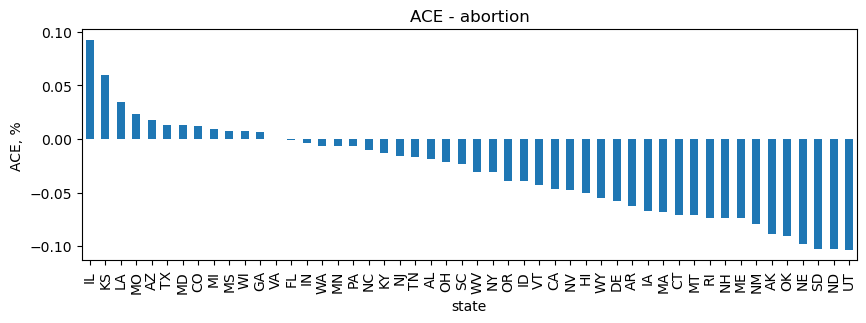Congressional Support
Let’s take a look at congressional data. This data is covers 5,000 legislative bills that were sponsored in Congress over 411 representatives (or the equivalent), 50 states (including some additional US territories) and 759 “subjects” (eg abortion, health, education, etc). In this notebook, we will use BBNs to estimate the lift of each state on sponsorship of a bill. We will also estimate the average causal effect (ACE) of states on subject sponsorship (eg what’s the ACE of California on sponsorship of abortion related legislative bills).
Initialize
Let’s load up the data, which has been transformed from its original “wide” form (each row is a legislative bill) to the “long” form below (each row is essentially a district’s sponsorship outcome).
[1]:
import pandas as pd
from pyspark.sql import SparkSession
def get_pdf(subject):
f = (pdf.subject==subject)
return pdf[f][['state', 'party', 'sponsor']]
def get_sdf(subject):
pdf = get_pdf(subject)
sdf = spark.createDataFrame(pdf)
return sdf
spark = SparkSession \
.builder \
.appName('diabetes') \
.master('local[*]') \
.config('spark.executor.memory', '5g') \
.config('spark.driver.memory', '10g') \
.config('spark.memory.offHeap.enabled', 'true') \
.config('spark.memory.offHeap.size', '5g') \
.getOrCreate()
states = [
'AL', 'AK', 'AZ', 'AR', 'CA', 'CO', 'CT',
'DE', 'FL', 'GA', 'HI', 'ID', 'IL', 'IN',
'IA', 'KS', 'KY', 'LA', 'ME', 'MD', 'MA',
'MI', 'MN', 'MS', 'MO', 'MT', 'NE', 'NV',
'NH', 'NJ', 'NM', 'NY', 'NC', 'ND', 'OH',
'OK', 'OR', 'PA', 'RI', 'SC', 'SD', 'TN',
'TX', 'UT', 'VT', 'VA', 'WA', 'WV', 'WI',
'WY'
]
pdf = pd.read_csv('./data/congress-state-party-subject.csv', low_memory=False)
pdf = pdf[pdf['state'].isin(states)]
pdf.shape
Setting default log level to "WARN".
To adjust logging level use sc.setLogLevel(newLevel). For SparkR, use setLogLevel(newLevel).
23/09/12 01:22:52 WARN NativeCodeLoader: Unable to load native-hadoop library for your platform... using builtin-java classes where applicable
[1]:
(5600190, 6)
[2]:
pdf.head(10)
[2]:
| state | district | subject | legislation | party | sponsor | |
|---|---|---|---|---|---|---|
| 0 | AK | AK_99 | armed_forces_and_national_security | H.R. 4140 | D | no |
| 1 | AL | AL_01 | armed_forces_and_national_security | H.R. 4140 | R | no |
| 2 | AL | AL_02 | armed_forces_and_national_security | H.R. 4140 | R | no |
| 3 | AL | AL_03 | armed_forces_and_national_security | H.R. 4140 | R | no |
| 4 | AL | AL_04 | armed_forces_and_national_security | H.R. 4140 | R | no |
| 5 | AL | AL_05 | armed_forces_and_national_security | H.R. 4140 | R | no |
| 6 | AL | AL_06 | armed_forces_and_national_security | H.R. 4140 | R | no |
| 7 | AL | AL_07 | armed_forces_and_national_security | H.R. 4140 | D | no |
| 8 | AR | AR_01 | armed_forces_and_national_security | H.R. 4140 | R | no |
| 9 | AR | AR_02 | armed_forces_and_national_security | H.R. 4140 | R | no |
BBN
The code below are bootstrap code to build a BBN from the data so that we can estimate lift and ACE. All structures are composed of a triplet \((X, Y, Z)\) where
\(X \rightarrow Y\),
\(Z \rightarrow Y\), and
\(Z \rightarrow X\).
In these structures,
\(X\) is collection of states (eg all the 50 states when computing lift) or an individual state (eg CA, VA, MD, etc when estimating ACE),
\(Y\) is the sponsorship (yes or no), and
\(Z\) is the confounder and set to the party (eg replican
Ror democratD).
Essentially, we want to know the impact of each state on sponsorship of legislative bill subjects.
[3]:
import networkx as nx
import matplotlib.pyplot as plt
from pysparkbbn.discrete.data import DiscreteData
from pysparkbbn.discrete.plearn import ParamLearner
from pysparkbbn.discrete.bbn import get_bbn
from pybbn.pptc.inferencecontroller import InferenceController
def get_structure(x='state', y='sponsor', z='party'):
g = nx.DiGraph()
g.add_node(x)
g.add_node(z)
g.add_node(y)
g.add_edge(z, x)
g.add_edge(z, y)
g.add_edge(x, y)
return g
def get_parameters(data, g):
param_learner = ParamLearner(data, g)
p = param_learner.get_params()
return p
def get_jt(subject):
d = DiscreteData(get_sdf(subject))
g = get_structure()
p = get_parameters(d, g)
b = get_bbn(g, p, d.get_profile())
t = InferenceController.apply(b)
return d, g, p, b, t
def plot_structure(g):
pos = nx.nx_pydot.graphviz_layout(g, prog='dot')
fig, ax = plt.subplots(figsize=(3, 3))
nx.draw(
g,
pos,
ax=ax,
with_labels=True,
node_size=10,
node_color='#2eb82e',
edge_color='#4da6ff',
arrowsize=10,
min_target_margin=5
)
ax.set_title('Congressional Support')
fig.tight_layout()
Lift
The states with the highest lift for the top 10 subjects (most frequently occuring subjects) are computed below.
[4]:
from pybbn.graph.jointree import EvidenceBuilder
def get_posterior(state, t, baseline_p):
ev = EvidenceBuilder() \
.with_node(t.get_bbn_node_by_name('state')) \
.with_evidence(state, 1.0) \
.build()
t.unobserve_all()
t.set_observation(ev)
posterior = t.get_posteriors()['sponsor']
lift = {
'lift_no': posterior['no'] / baseline_p['no'],
'lift_yes': posterior['yes'] / baseline_p['yes']
}
baseline = {
'base_no': baseline_p['no'],
'base_yes': baseline_p['yes']
}
posterior = {
'post_no': posterior['no'],
'post_yes': posterior['yes']
}
d = {'state': state}
d = {**d, **baseline}
d = {**d, **posterior}
d = {**d, **lift}
return d
def get_lift(t, subject):
t.unobserve_all()
baseline_p = t.get_posteriors()['sponsor']
return pd.DataFrame([get_posterior(state, t, baseline_p) for state in pdf.state.unique()]) \
.assign(subject=subject) \
.sort_values(['lift_yes'], ascending=False) \
.head(1)
def f(subject):
*_, t = get_jt(subject)
return get_lift(t, subject)
You can see that DE provides the highest lift for legislative bills associated with the “health” subject. The columns below are explained as follows.
state: the state (1 of 50) that generates the highest lift for sponsorship (yes)base_no: the marginal percentage of no sponsorship,base_yes: the marginal percentage of yes sponsorship,post_no: the posterior probability of no sponsorship given the corresponding state,post_yes: the posterior probability of yes sponsorship given the corresponding state,lift_no: the lift of no sponsorship (eg base_no / post_no)lift_yes: the lift of yes sponsorship (eg base_yes / post_yes)subject: the legislative bill subject
[5]:
lift_df = pd.concat([f(subject) for subject in pdf.groupby(['subject']).size().sort_values(ascending=False).index[:10]])
lift_df
23/09/12 01:23:10 WARN GarbageCollectionMetrics: To enable non-built-in garbage collector(s) List(G1 Concurrent GC), users should configure it(them) to spark.eventLog.gcMetrics.youngGenerationGarbageCollectors or spark.eventLog.gcMetrics.oldGenerationGarbageCollectors
[5]:
| state | base_no | base_yes | post_no | post_yes | lift_no | lift_yes | subject | |
|---|---|---|---|---|---|---|---|---|
| 7 | DE | 0.962814 | 0.037186 | 0.873706 | 0.126294 | 0.907451 | 3.396263 | health |
| 25 | MT | 0.969950 | 0.030050 | 0.884615 | 0.115385 | 0.912021 | 3.839793 | international_affairs |
| 25 | MT | 0.975434 | 0.024566 | 0.870833 | 0.129167 | 0.892765 | 5.257993 | government_operations_and_politics |
| 29 | NH | 0.973497 | 0.026503 | 0.935252 | 0.064748 | 0.960714 | 2.443058 | armed_forces_and_national_security |
| 10 | HI | 0.954627 | 0.045373 | 0.925182 | 0.074818 | 0.969156 | 1.648946 | crime_and_law_enforcement |
| 10 | HI | 0.963228 | 0.036772 | 0.940476 | 0.059524 | 0.976380 | 1.618705 | congressional_oversight |
| 48 | WV | 0.970921 | 0.029079 | 0.938247 | 0.061753 | 0.966348 | 2.123622 | taxation |
| 25 | MT | 0.984835 | 0.015165 | 0.844538 | 0.155462 | 0.857542 | 10.251592 | congress |
| 10 | HI | 0.965579 | 0.034421 | 0.902703 | 0.097297 | 0.934882 | 2.826715 | education |
| 10 | HI | 0.962791 | 0.037209 | 0.921512 | 0.078488 | 0.957126 | 2.109375 | government_information_and_archives |
Average Causal Effect (ACE )
Now we will see the ACE of each state on sponsorship for selected subjects.
[6]:
from pybbn.causality.ace import Ace
def get_states(subject):
return list(pdf.query(f'subject == "{subject}"')['state'].unique())
def get_ace(subject, state):
d = pdf \
.query(f'subject == "{subject}"') \
.assign(**{
state: lambda d: d['state'].apply(lambda s: 'yes' if s == state else 'no')
}) \
[[state, 'party', 'sponsor']]
d = spark.createDataFrame(d)
d = DiscreteData(d)
g = get_structure(x=state, y='sponsor', z='party')
p = get_parameters(d, g)
b = get_bbn(g, p, d.get_profile())
t = InferenceController.apply(b)
a = Ace(b).get_ace(state, 'sponsor', 'yes')
y = a['yes']
n = a['no']
diff = y - n
return {
'subject': subject,
'state': state,
'yes': y,
'no': n,
'ace': diff
}
Health
As you can see below, AL has the highest, positive ACE on health legislative bills. UT actually has the highest, negative ACE on health bills.
[7]:
subject = 'health'
_df_health = pd.DataFrame([get_ace(subject, s) for s in get_states(subject)]) \
.sort_values(['ace'], ascending=False) \
.reset_index(drop=True)
[25]:
_ = _df_health.set_index(['state'])['ace'] \
.plot(kind='bar', figsize=(10, 3), title='ACE - health', ylabel='ACE, %')
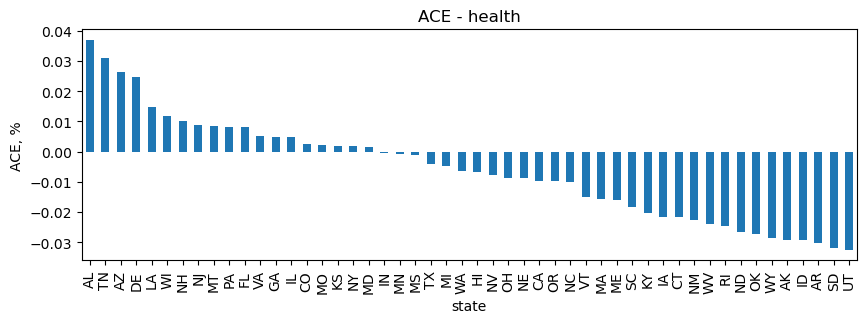
International affairs
TN ranks first with the highest, positive ACE on international affairs bills, and AK has the highest, negative ACE on these bills.
[8]:
subject = 'international_affairs'
_df_ia = pd.DataFrame([get_ace(subject, s) for s in get_states(subject)]) \
.sort_values(['ace'], ascending=False) \
.reset_index(drop=True)
[26]:
_ = _df_ia.set_index(['state'])['ace'] \
.plot(kind='bar', figsize=(10, 3), title='ACE - international affairs', ylabel='ACE, %')

Government operations and politics
MT has the highest, positive ACE on government operations and politics bills, while AK has the highest, negative ACE.
[9]:
subject = 'government_operations_and_politics'
_df_gov_op = pd.DataFrame([get_ace(subject, s) for s in get_states(subject)]) \
.sort_values(['ace'], ascending=False) \
.reset_index(drop=True)
[27]:
_ = _df_gov_op.set_index(['state'])['ace'] \
.plot(kind='bar', figsize=(10, 3), title='ACE - government operations and politics', ylabel='ACE, %')
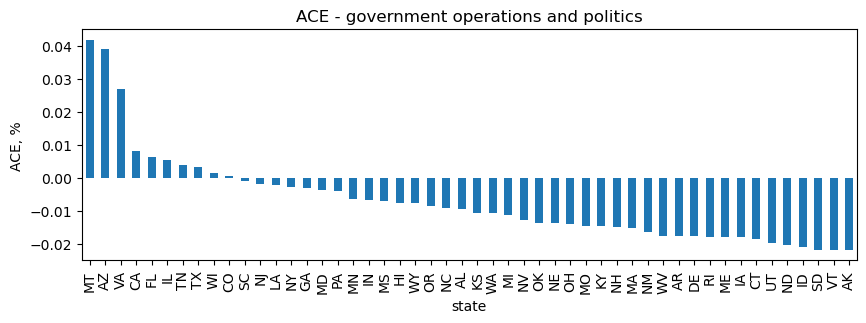
Armed forces and national security
For armed forces and national security, IN has the highest, positive ACE and VT has the highest, negative ACE.
[10]:
subject = 'armed_forces_and_national_security'
_df_afns = pd.DataFrame([get_ace(subject, s) for s in get_states(subject)]) \
.sort_values(['ace'], ascending=False) \
.reset_index(drop=True)
[28]:
_ = _df_afns.set_index(['state'])['ace'] \
.plot(kind='bar', figsize=(10, 3), title='ACE - armed forces and national security', ylabel='ACE, %')
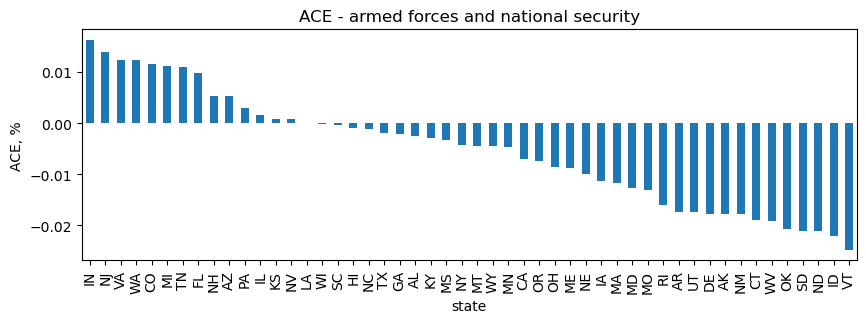
Crime and law enforcement
For crime and law enforcement, IL has the highest, positive ACE and AK has the highest, negative ACE.
[11]:
subject = 'crime_and_law_enforcement'
_df_cle = pd.DataFrame([get_ace(subject, s) for s in get_states(subject)]) \
.sort_values(['ace'], ascending=False) \
.reset_index(drop=True)
[29]:
_ = _df_cle.set_index(['state'])['ace'] \
.plot(kind='bar', figsize=(10, 3), title='ACE - crime and law enforcement', ylabel='ACE, %')
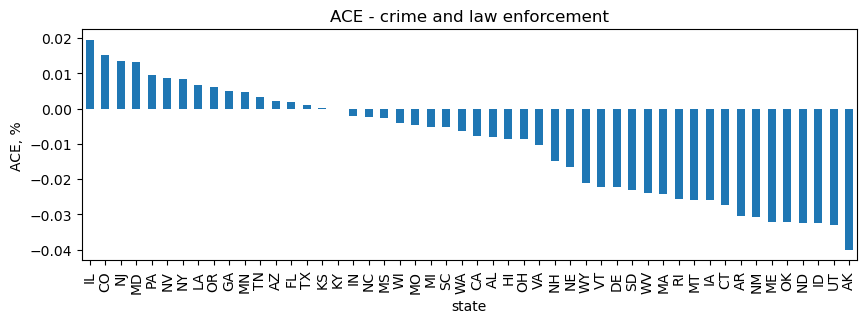
Abortion
For bills whose subjects include abortion, IL has the highest, positive ACE and UT, ND and SD have comparably the highest, negative ACE. It’s interesting to note that only 12 of 50 states have a positive ACE on abortion bill sponsorship.
[12]:
subject = 'abortion'
_df_abortion = pd.DataFrame([get_ace(subject, s) for s in get_states(subject)]) \
.sort_values(['ace'], ascending=False) \
.reset_index(drop=True)
[30]:
_ = _df_abortion.set_index(['state'])['ace'] \
.plot(kind='bar', figsize=(10, 3), title='ACE - abortion', ylabel='ACE, %')
